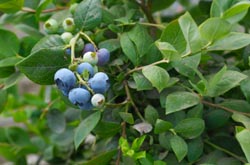Vision Quest: The Benefits of Bilberry
In observance of National Save Your Vision Month, we have some eye-opening news you can use to help preserve your eyesight. Bilberry, a cousin to the blueberry and cranberry, is loaded with antioxidants and other compounds that may provide protection against vision problems, namely retinal deterioration and cataracts. As an added bonus, bilberry may also help to reduce your risk of heart disease and cancer.
 Bilberry
Bilberry (Vaccinium myrtillus L.) is a low-growing shrub that is related to the blueberry, cranberry and huckleberry. It is also known by a long list of common names that includes myrtle blueberry, dyeberry, trackleberry, whortleberry, bleaberry, burren myrtle, wineberry hurts, winberry, Airelle, fraughan, black whortles and black hearts, the latter being fictionalized in The Return of the Native by the 19th century novelist, Thomas Hardy. This particular species, which is found throughout Europe, Northern Asia and Western North America, is harvested for its deliciously tart berries to make jams and pies. However, the fresh and dried
bilberry fruit, as well as the dried leaf, have also been used in medicine for centuries. In fact, studies suggest that the antioxidant content of bilberry may help to prevent a number of diseases, including atherosclerosis, cancer and age-related macular degeneration.
An Herb to Take to Heart
Bilberry leaf and fruit contain a variety of antioxidant compounds that may prevent the development of cardiovascular disease. In addition to vitamin C, the berries contain plant chemicals known as anthocyanosides, among them quercetrin and hyperoside. Collectively, these agents exert several positive health effects. First, they prevent free radicals from causing oxidative damage in cells, which might otherwise trigger the generation of rogue cancer cells. Anthocyanosides also help to strengthen the walls of blood vessels and, because they promote the relaxation of vein and capillary smooth tissue, they increase the circulation of blood. In fact, bilberry is traditionally used to counter venous insufficiency, a condition characterized by a reduced volume of blood returning to the heart from the legs. Bilberry anthocyanosides also prevent blood platelet aggregation, which can cause blood clots that can lead to a heart attack or stroke. Bilberry leaf extract appears to provide some protection against the development of atherosclerosis by lowering levels of LDL cholesterol, which is largely responsible for the formation of arterial plaque.
Old Knowledge is New Again
Modern research has found that extracts of the fruit and leaf demonstrate other medicinal benefits, many of which have been known to generations of herbalists. For instance, studies have shown that certain compounds in the berries inhibit the activity of histamine, a mechanism attributed to the ability to speed the healing of wounds and gastrointestinal ulcers. These benefits are due to the presence of catechin tannins, plant chemicals that are both astringent and anti-inflammatory.
Bilberry is traditionally recommended by herbalists to relieve skin irritations, minor wounds, stomach complaints and diarrhea, although the latter use has not been substantiated by clinical research. Some bilberry compounds are, however, recognized as being antiviral and antibacterial. In fact, research on the effects of bilberry leaf extracts show that this herb is effective against several strains, including Escherichia coli and Staphylococcus aureus.
Bilberry is also used to help reduce blood sugar. Unfortunately, this effect has only been observed in animals and has not yet been studied in people, making its use for insulin-dependent diabetics risky. However, there is evidence to support the use of bilberry to counteract diabetic retinopathy and other disorders of the eye.
Vision for the Future
Bilberry anthocyanosides are reputed to help resolve vision problems, night vision in particular. This belief largely stems from accounts of World War II British pilots, who claimed to be able to see better at night as the result of consuming bilberry jam. Research is limited in this area, and what studies on the effects of bilberry on night vision that have been done have produced mixed results. But, researchers do know that plant anthocyanosides increase the production of rhodopsin, a pigment found in the retina that is involved in the formation of photoreceptor cells. This substance also reduces light sensitivity, which may explain the connection between bilberry and enhanced night vision. In addition, since bilberry shows protective effects on the retina, it may be a potential therapy in the treatment and prevention of retinopathy, macular degeneration and cataracts.
How can you use bilberry to help protect your peepers? Enjoy the dried leaf and berries as a tea, and the fresh berries in jam, jelly, pancakes, muffins, pies and in other baked goods. Although
bilberries taste similar to fresh blueberries, they aren’t quite as sweet.
Since this herb may increase the effects of blood-thinning medications and drugs that lower blood sugar, use caution if you take these medications or use other herbs that promote these effects.